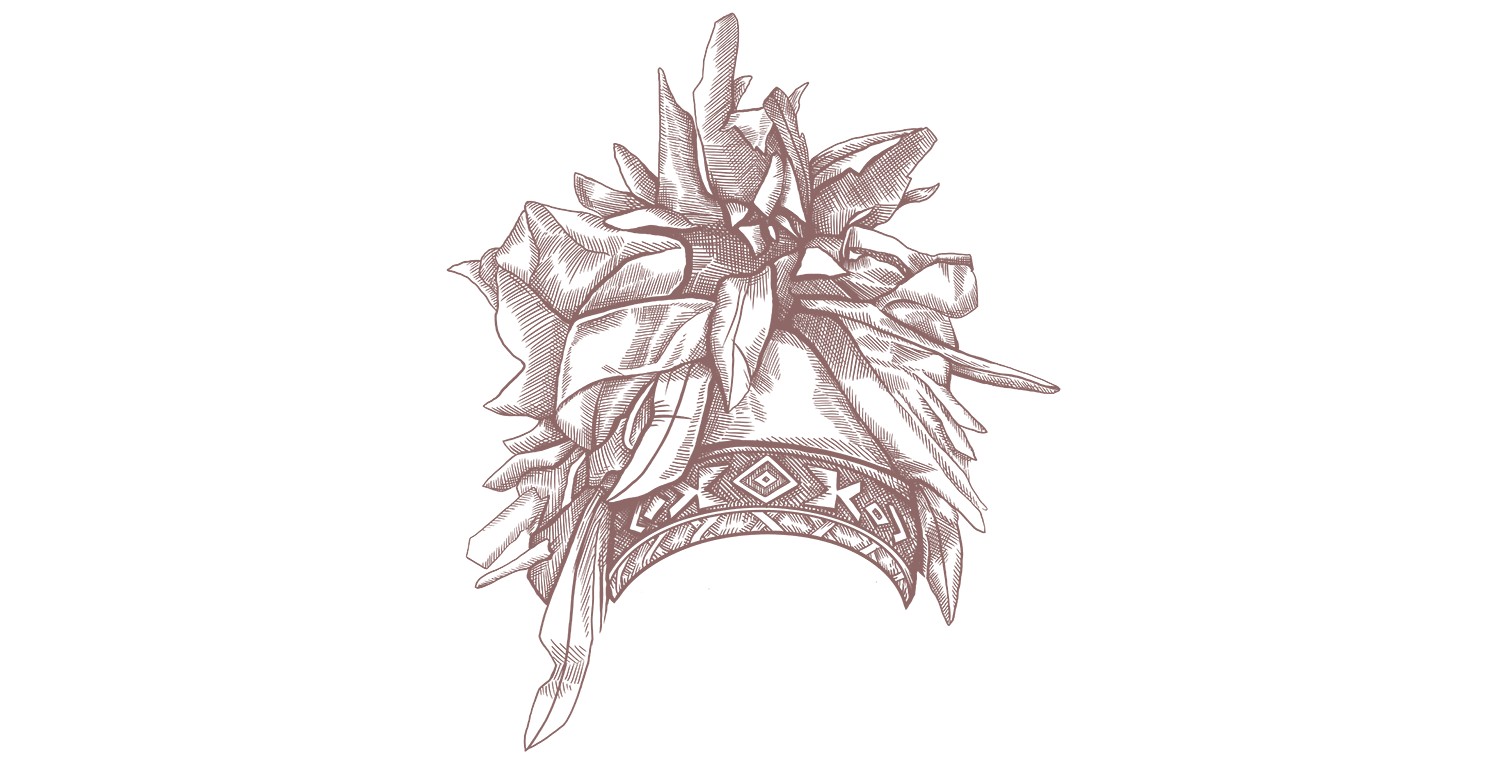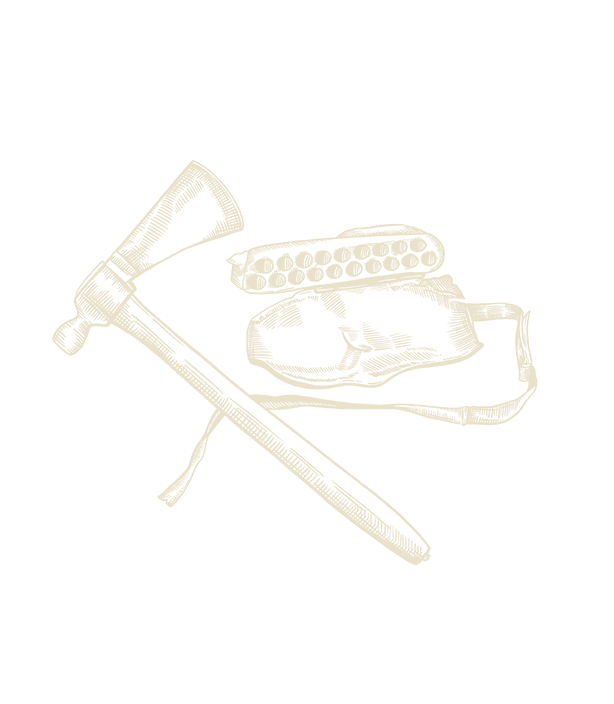
Investigating certain Patriots of Color sometimes reveals a great irony in history—that very prominent people, who had very public, high-impact roles in the Revolutionary War, have had very little formally written about them. This is arguably the case when we consider a figure like Nicholas Cusick, an American Indian Patriot. Cusick, whose Native American name was “Kayh-natho,” was born in 1756 in Oneida, New York. 1 A highly respected sachem/chief of the Tuscarora nation,2 he was one of the few pensioned Indians out of the many that served in the war.3
The Tuscarora entered the American Revolution through circumstances that were comparatively unique in the Northeast, for, unlike the five Iroquois Nations, the Tuscarora were not originally from the New York region.4 Before 1713, they inhabited the Carolinas, but, after the Tuscarora War, they departed for New York to join the Iroquois Confederacy.5 There is little information on the actions of the Tuscarora during the American Revolution, but it is known that the Tuscarora had sided with the Americans during the conflict.6 Some of those who contributed to the efforts of the Continental Army fought as warriors, while other participants such as Cusick were intelligence gatherers, as well.7 He would serve in the war for a total of five years, collecting intelligence on enemy Native American groups, and their movements, for the Americans.8 Cusick also worked as an interpreter, often consulted George Washington as an Indian affairs expert, and would combat the British in the Battle of Saratoga.9 Although the Oneida, another member of the Iroquois Confederacy, were divided over whether to support the British or the Americans, Cusick would manage to successfully recruit Oneida warriors, as well as other Tuscarora, for the American side.10 He perhaps became most notable for operating as the General Marquis de Lafayette’s bodyguard during the war years, having been credited with saving Lafayette’s life.11 Following the war’s conclusion, Cusick accompanied a missionary to Buffalo, New York, where he served as an interpreter in negotiations with chiefs of the Seneca mission, and by 1802, he permanently relocated his family to a Tuscarora reservation situated near Niagara Falls.12
Sources
“Nicholas Cusick,” Virtual American Biographies, accessed April 25, 2022, http://famousamericans.net/nicholascusick/.
Roberta Estes, “Nicholas Cusick – Revolutionary War Patriot, Sachem, Tuscarora Chief,” Native Heritage Project (blog), May 2, 2012, https://nativeheritageproject.com/2012/05/02/nicholas-cusick-revolutionary-war-patriot-sachem-tuscarora-chief/.
Roberta Estes, “Nicholas Cusick – Revolutionary War Patriot, Sachem, Tuscarora Chief,” Native Heritage Project (blog), May 2, 2012, https://nativeheritageproject.com/2012/05/02/nicholas-cusick-revolutionary-war-patriot-sachem-tuscarora-chief/.
Marie Danielle Annette Williams, The Revolutionary War in the Adirondacks: Raids in the Wilderness (Charleston, SC: The History Press, 2020), “Tuscarora.”
Marie Danielle Annette Williams, The Revolutionary War in the Adirondacks: Raids in the Wilderness (Charleston, SC: The History Press, 2020), “Tuscarora.”
Marie Danielle Annette Williams, The Revolutionary War in the Adirondacks: Raids in the Wilderness (Charleston, SC: The History Press, 2020), “Tuscarora.”
Marie Danielle Annette Williams, The Revolutionary War in the Adirondacks: Raids in the Wilderness (Charleston, SC: The History Press, 2020), “Tuscarora.”

By any standard or metric, Nicholas Cusick’s service in the American War of Independence was remarkable.
Cusick applied for a pension several times—of note are the applications of 1818 and 1826. In the 1818 pension application for those who were impoverished or disabled,13 he revealed that he had a wife and 10 children.14 In the application of 1826, he provided the age of his wife as approximately 56 and stated that he had residing with him two daughters and three grandchildren, children of a deceased daughter, but he revealed no names.15 Cusick would eventually receive a pension and bounty land in Seneca County, New York—500 acres initially, with an additional 2000 possible at some point.16 Notwithstanding this, one of his sons, in a letter to President Millard Filmore, stated that Nicholas was “cheated of it.”17 The specifics and truth of such a claim cannot be verified, however. Cusick passed away in 1840 and was interred at Mount Hope Cemetery in Lewiston, New York.18
By any standard or metric, Nicholas Cusick’s service in the American War of Independence was remarkable. Given that he was an American Indian, the extent to which he was able to actively contribute to the war, as well as the collaboration he had with and effect he had upon notable individuals within it, made him an extraordinarily significant addition to the American front against the British—and should cement his legacy as a Patriot of Color. As so few Indigenous Americans of such caliber are available for research and reflection, the life and accomplishments of Cusick should vividly show the centrality of the American Indians’ presence and participation in the Revolutionary movement.
Sources
Marie Danielle Annette Williams, The Revolutionary War in the Adirondacks: Raids in the Wilderness (Charleston, SC: The History Press, 2020), “Tuscarora.”
“Lewiston’s Most Famous Visitor: Lafayette in 1825,” Lewiston History Mysteries, Spring 2014, https://historiclewiston.org/wp-content/uploads/2016/06/Lafayette.pdf.
Ojibwa, “The Revolutionary War and American Indians,” Daily Kos, July 20, 2010, https://www.dailykos.com/stories/2010/7/20/885871/-. See, also, “Three Iroquois: Atotárho Protected by Black Snakes, Flanked by Deganawida(?) Offering Wampum and Hiawatha(?),” New-York Historical Society, accessed April 25, 2022, https://emuseum.nyhistory.org/objects/45020/three-iroquois-atotarho-protected-by-black-snakes flanked;jsessionid=8CE3C18FCCDF1850DA49F68BC61FD249?ctx=8b13fbdc912ec7fb7ac63c3f0a02bb652a683e30&idx=23.
“Lewiston’s Most Famous Visitor: Lafayette in 1825,” Lewiston History Mysteries, https://historiclewiston.org/wp-content/uploads/2016/06/Lafayette.pdf.
“Three Iroquois: Atotárho Protected by Black Snakes, Flanked by Deganawida(?) Offering Wampum and Hiawatha(?),” New-York Historical Society, https://emuseum.nyhistory.org/objects/45020/three-iroquois-atotarho-protected-by-black-snakes flanked;jsessionid=8CE3C18FCCDF1850DA49F68BC61FD249?ctx=8b13fbdc912ec7fb7ac63c3f0a02bb652a683e30&idx=23.
Roberta Estes, “Nicholas Cusick – Revolutionary War Patriot, Sachem, Tuscarora Chief,” https://nativeheritageproject.com/2012/05/02/nicholas-cusick-revolutionary-war-patriot-sachem-tuscarora-chief/.
“Pension Application for Nicholas Cusick,” Revolutionary War Pensions, New York State Applicants, accessed April 25, 2022, http://www.revwarpensions.com/cusicknicholas.pdf
“Pension Application for Nicholas Cusick,” Revolutionary War Pensions, New York State Applicants, accessed April 25, 2022, http://www.revwarpensions.com/cusicknicholas.pdf
Roberta Estes, “Nicholas Cusick – Revolutionary War Patriot, Sachem, Tuscarora Chief,” https://nativeheritageproject.com/2012/05/02/nicholas-cusick-revolutionary-war-patriot-sachem-tuscarora-chief/.
Roberta Estes, “Nicholas Cusick – Revolutionary War Patriot, Sachem, Tuscarora Chief,” https://nativeheritageproject.com/2012/05/02/nicholas-cusick-revolutionary-war-patriot-sachem-tuscarora-chief/.
“NIAGARA DISCOVERIES: Cornelius Cusick, Civil War hero,” The Lockport Union-Sun & Journal online, June 28, 2014, https://www.lockportjournal.com/opinion/niagara-discoveries-cornelius-cusick-civil-war-hero/article_eb4f89b9-0d4b-56e8-b592-f722c2831c71.html.
Sources
“Nicholas Cusick,” Virtual American Biographies, accessed April 25, 2022, http://famousamericans.net/nicholascusick/.
Roberta Estes, “Nicholas Cusick – Revolutionary War Patriot, Sachem, Tuscarora Chief,” Native Heritage Project (blog), May 2, 2012, https://nativeheritageproject.com/2012/05/02/nicholas-cusick-revolutionary-war-patriot-sachem-tuscarora-chief/.
Roberta Estes, “Nicholas Cusick – Revolutionary War Patriot, Sachem, Tuscarora Chief,” Native Heritage Project (blog), May 2, 2012, https://nativeheritageproject.com/2012/05/02/nicholas-cusick-revolutionary-war-patriot-sachem-tuscarora-chief/.
Marie Danielle Annette Williams, The Revolutionary War in the Adirondacks: Raids in the Wilderness (Charleston, SC: The History Press, 2020), “Tuscarora.”
Marie Danielle Annette Williams, The Revolutionary War in the Adirondacks: Raids in the Wilderness (Charleston, SC: The History Press, 2020), “Tuscarora.”
Marie Danielle Annette Williams, The Revolutionary War in the Adirondacks: Raids in the Wilderness (Charleston, SC: The History Press, 2020), “Tuscarora.”
Marie Danielle Annette Williams, The Revolutionary War in the Adirondacks: Raids in the Wilderness (Charleston, SC: The History Press, 2020), “Tuscarora.”
Marie Danielle Annette Williams, The Revolutionary War in the Adirondacks: Raids in the Wilderness (Charleston, SC: The History Press, 2020), “Tuscarora.”
“Lewiston’s Most Famous Visitor: Lafayette in 1825,” Lewiston History Mysteries, Spring 2014, https://historiclewiston.org/wp-content/uploads/2016/06/Lafayette.pdf.
Ojibwa, “The Revolutionary War and American Indians,” Daily Kos, July 20, 2010, https://www.dailykos.com/stories/2010/7/20/885871/-. See, also, “Three Iroquois: Atotárho Protected by Black Snakes, Flanked by Deganawida(?) Offering Wampum and Hiawatha(?),” New-York Historical Society, accessed April 25, 2022, https://emuseum.nyhistory.org/objects/45020/three-iroquois-atotarho-protected-by-black-snakes flanked;jsessionid=8CE3C18FCCDF1850DA49F68BC61FD249?ctx=8b13fbdc912ec7fb7ac63c3f0a02bb652a683e30&idx=23.
“Lewiston’s Most Famous Visitor: Lafayette in 1825,” Lewiston History Mysteries, https://historiclewiston.org/wp-content/uploads/2016/06/Lafayette.pdf.
“Three Iroquois: Atotárho Protected by Black Snakes, Flanked by Deganawida(?) Offering Wampum and Hiawatha(?),” New-York Historical Society, https://emuseum.nyhistory.org/objects/45020/three-iroquois-atotarho-protected-by-black-snakes flanked;jsessionid=8CE3C18FCCDF1850DA49F68BC61FD249?ctx=8b13fbdc912ec7fb7ac63c3f0a02bb652a683e30&idx=23.
Roberta Estes, “Nicholas Cusick – Revolutionary War Patriot, Sachem, Tuscarora Chief,” https://nativeheritageproject.com/2012/05/02/nicholas-cusick-revolutionary-war-patriot-sachem-tuscarora-chief/.
“Pension Application for Nicholas Cusick,” Revolutionary War Pensions, New York State Applicants, accessed April 25, 2022, http://www.revwarpensions.com/cusicknicholas.pdf
“Pension Application for Nicholas Cusick,” Revolutionary War Pensions, New York State Applicants, accessed April 25, 2022, http://www.revwarpensions.com/cusicknicholas.pdf
Roberta Estes, “Nicholas Cusick – Revolutionary War Patriot, Sachem, Tuscarora Chief,” https://nativeheritageproject.com/2012/05/02/nicholas-cusick-revolutionary-war-patriot-sachem-tuscarora-chief/.
Roberta Estes, “Nicholas Cusick – Revolutionary War Patriot, Sachem, Tuscarora Chief,” https://nativeheritageproject.com/2012/05/02/nicholas-cusick-revolutionary-war-patriot-sachem-tuscarora-chief/.
“NIAGARA DISCOVERIES: Cornelius Cusick, Civil War hero,” The Lockport Union-Sun & Journal online, June 28, 2014, https://www.lockportjournal.com/opinion/niagara-discoveries-cornelius-cusick-civil-war-hero/article_eb4f89b9-0d4b-56e8-b592-f722c2831c71.html.
More Patriot Profiles
Jack Congo
The course of the life of Jack Congo (alternatively, Congo Jack) showed how the relationship between slavery ...
Drury Walden
Perhaps surprisingly, there were Patriots of Color who enlisted in the American Revolutionary War as free men—even ...
Andrew Ferguson
The contribution of Patriots such as Andrew Ferguson reflected the distinct ways that certain independent Blacks could ...
